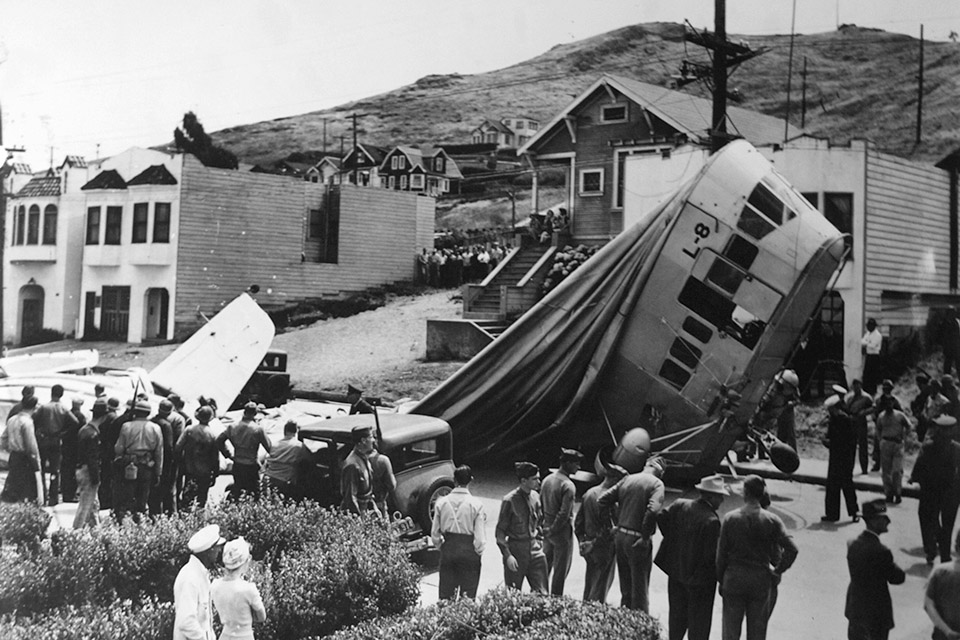Construction
The L-8 was a Goodyear, L-class blimp, purchased by the US Navy for its coastal patrol mission which was rapidly building due to the bombing of Pearl Harbour in 1941. From 1937 to 1943 the US Navy procured quite a number of blimps from Goodyear, and many of them were previously operational commercial blimps which Goodyear simply "sold" to the Navy. What became the L-8 was previously one of the many Goodyear advertising blimps, known at Goodyear as "Ranger". In piecing together the history of the L-8, one becomes quickly confused by dates and the "names" Goodyear employed. But here is what I have determined. (If any of this is wrong, I'd appreciate being contacted with the correction):
In 1941, the original Ranger blimp (built in 1940, not the Ranger that became the L-8) was sold to the US Navy. This "Ranger" became the Navy "L-2". This Ranger/L-2 then was destroyed on 8 June, 1942 when it collided with the Navy blimp G-1 at sea. (The G-1 was also destroyed in the collision.)
In the mean time in 1941, Goodyear had built a blimp to replace the original Ranger, which it had sold to the Navy. The new blimp was also called "Ranger" though it had a larger envelope. By this time, Pearl Harbour had been attacked, and the US Navy wanted more blimps for wartime service as submarine patrol craft, so in early 1942, Goodyear sold to the Navy, the available commercial blimps: Resolute, Enterprise, Reliance, Rainbow, and (the "new") Ranger to the Navy. These five L-class blimps became the L-4 to L-8, with the "new" Ranger becoming the L-8.
(Goodyear supplied additional L-class blimps to the US Navy until 1943. The L-9 to L-12 were constructed at the Navy's facility at Moffett Field, and an additional 10, L-class blimps were ordered from Goodyear becoming the L-13 to L-22.)
In summary, the first "Ranger" Goodyear blimp became the "L-2" and was lost in an accident. The second "Ranger" built by Goodyear to replace the original Ranger was then purchased by the Navy along with 4 other L-class commercial Goodyear blimps. This second "Ranger" became the L-8.
Specifications of the L-8:
Volume: 123,000 cu. ft.
Length: 148 ft.
Diameter: 46 ft.
Engines: 2 Warner R-500-2 Radial (145 hp ea)
Max speed: 63 mph
Cruising speed: 45 mph
Operations
The L-8 was stationed at Moffett Field part of Blimp Squadron 32 (ZP-32) operating out of Naval Station Treasure Island in San Francisco Bay.
The L-8 Would launch early in the morning with a crew of two, carrying two depth charges, some small arms and a machine gun. The blimp would be take out to sea to scout for submarines where they would navigate toward any unknown objects to investigate. Patrol flights could last nearly 12 hours.
Demise
On 16 August, 1942, a routine patrol flight began at 6 AM. The flight had scheduled a crew of three, but the blimp was "heavy" that morning due to heavy dew from the morning fog and one of the crew was dismissed to save weight.
During the morning, less than 2 hours into the patrol something went terribly wrong, and for unknown reasons still today, the crew vanished from the cabin. Though all sorts of theories still circulate about the disappearance of the crew the mystery remains. (There are many web pages dedicated to the mystery of the L-8, so the details will not be reproduced here. Simply search on the Navy blimp L-8 on the Internet and enjoy. It's quite a mystery.)
Adrift, with no crew, the L-8 ascended to its pressure ceiling at which time automatic valves in the envelope opened to vent helium so the envelope would not burst. Blown toward land, and descending, the blimp was observed by countless thousands on beaches and roads. Already folding due to the reduced helium, no engines running, and no one on board to operate the air bladder to maintain the blimp's shape, the L-8 impacted the cliffs of Ocean Beach, south of San Francisco. The impact dislodged one of the two depth charges. Now free of the weight of the depth charge, the L-8 ascended again. Unable to maintain altitude and at the mercy of the wind, the L-8 ultimately crashed on a city street in Daly City, about 5 miles SSW of central San Francisco.
Ignominious End
The Navy, of course, secured the area of the crash an investigated. The remnants of the L-8 were gathered and sent to Goodyear where the control car and engines remained in storage until 1969. In that year, Goodyear refurbished the gondola, gave it new engines and attached it to a new envelope and named this new blimp "America", now a type "GZ-20" blimp. The America served as an advertising blimp till it was retired in 1982.
Finally, with the America out of service, Goodyear restored the gondola to its "L-8" configuration, and since 2003 the gondola has been on display at the Naval Aviation Museum in Pensacola, FL.
Sites of Interest
Daly City, California. The crash site:
The site of the crash, of course is notorious. The location is in the 400 block of Bellevue Avenue in Daly City.
Photo credits: Undetermined.
Photo credits: Undetermined.
The location of the crash site in Daly City is at (Lat Lon) 37.705670 -122.449091:
Photo credits: Google Earth
The crash location today (2015) as seen in Google Street View:
Photo credits: Google Street View
Note: There is another excellent website with some fine comparison photos of the L-8 crash in 1942, with the street scenes today. The site is check-six.com.
And the restored L-8 control car at the Naval Aviation Museum, Pensacola, FL:
Photo credits: Naval Aviation Museum





